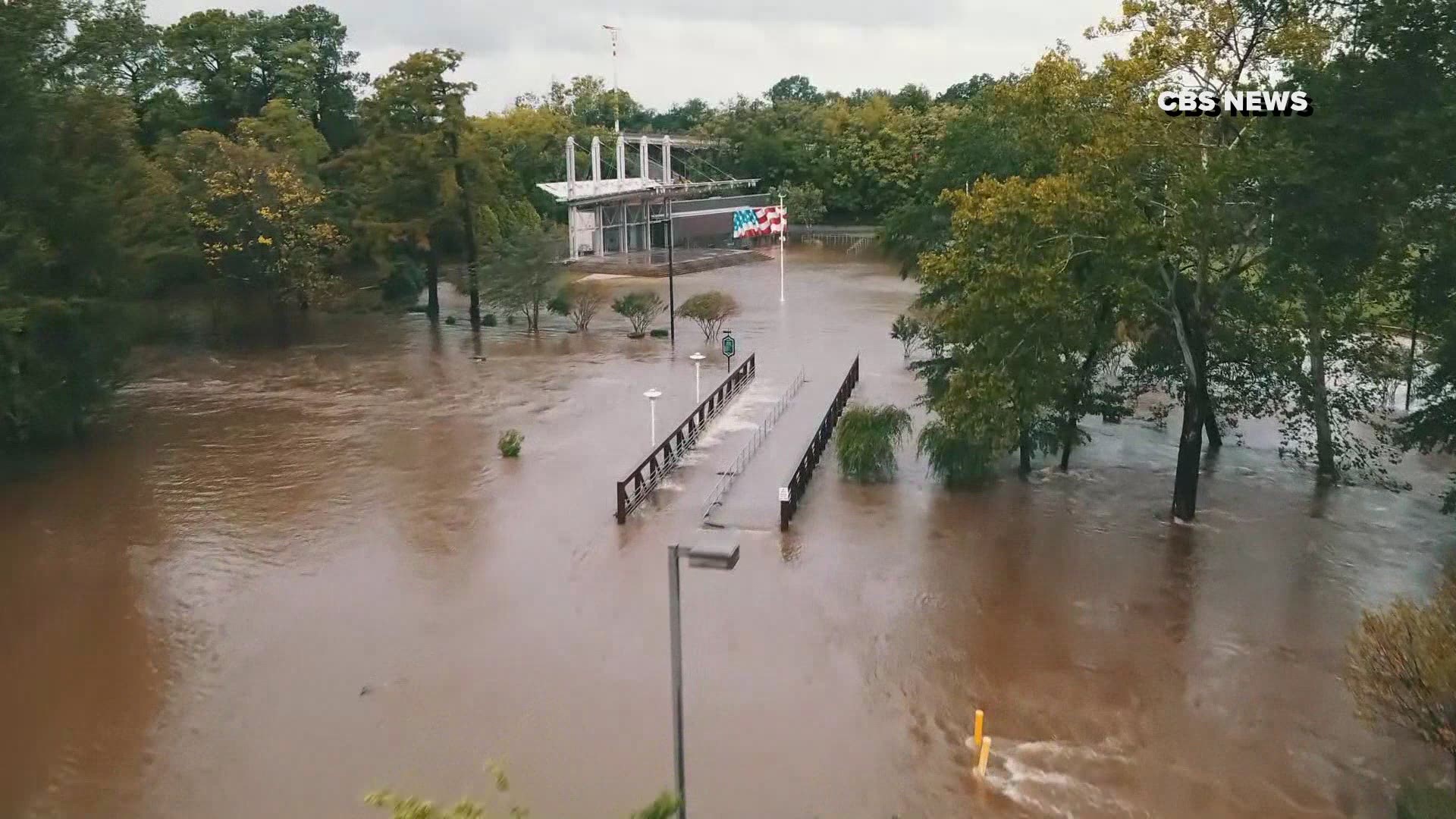GREENSBORO, N.C. — Every minute counts before, during, and after a hurricane hits. Precious minutes could mean the difference between life and death. That's why it's so critical to have a safety plan in place.
WFMY News 2 wants to make sure you know what to do now to prepare your home and keep your family safe, in the event of a hurricane.
In this "Storm Track 2 guide," you’ll find evacuation routes, emergency apps and contacts, hurricane preparedness, how to set up your phone to receive emergency alerts, hurricane survival kit supplies, and what to do before, during, and after a hurricane. Emergency information provided by FEMA and Ready NC.
INLAND HURRICANE IMPACTS
Even if you don't live near coastal areas, hurricanes can still move inland bringing with it destruction and flooding. Hurricane Matthew and Florence serve as a reminder of the devastation a hurricane can bring inland.

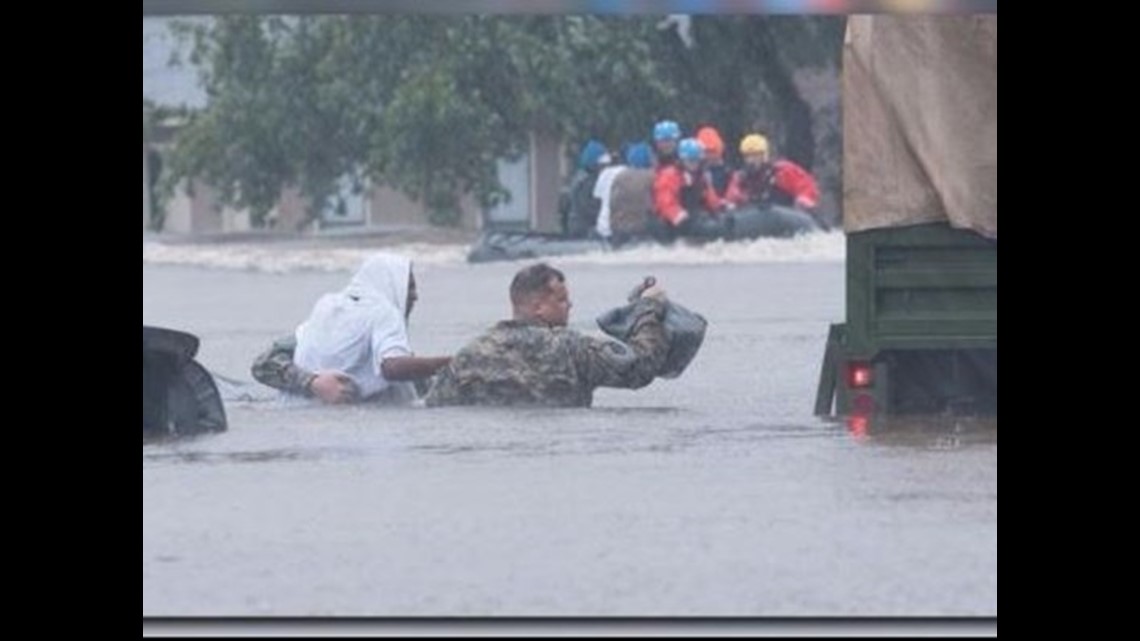
HURRICANE THREATS
Hurricanes include powerful winds, heavy rainfall, storm surges, coastal and inland flooding, rip currents, tornadoes, and even landslides.
KNOW THE TERMS
- Hurricane Watch – hurricane conditions (sustained winds greater than 74 mph) are possible. Watches are usually issued 48 hours before the beginning of tropical-storm-force-winds.
- Hurricane Warning – hurricane conditions (sustained winds greater than 74 mph) are expected. Warnings are usually issued 36 hours before the beginning of tropical-storm-force-winds.
- Tropical Storm Warning – tropical storm conditions (sustained winds of 39 to 73 mph) are possible within 36 hours.
WEATHER ALERTS
Make sure you download the WFMY News 2 App and the WFMY News 2 Weather App for the latest news and emergency information.
DOWNLOAD NOW
WFMY News 2 App: Apple Users, Android Users
WFMY News 2 Radar App: Apple Users, Android Users
If the power or cable goes out, you'll still be able to connect online. Download the WFMY News 2 App for live streaming video, updated weather forecasts, and reports from our field crews.
Both iPhone and Android allow users to customize notifications for when storms, tornadoes, hurricanes, or other severe weather is coming.
AFTER YOU DOWNLOAD THE APP
No matter whether you use an iPhone or Android, the process is the same.
STEP ONE: Open the WFMY News 2 App.
STEP TWO: Tap the gear in the top right corner.
STEP THREE: Tap “Notifications,” and find “Severe Weather Alerts.”
STEP FOUR: Make sure to turn on notifications, and you can pick how many alerts you get.
- If you want more, tap the option with statements and advisories.
- If you want fewer, tap the option with warnings only.

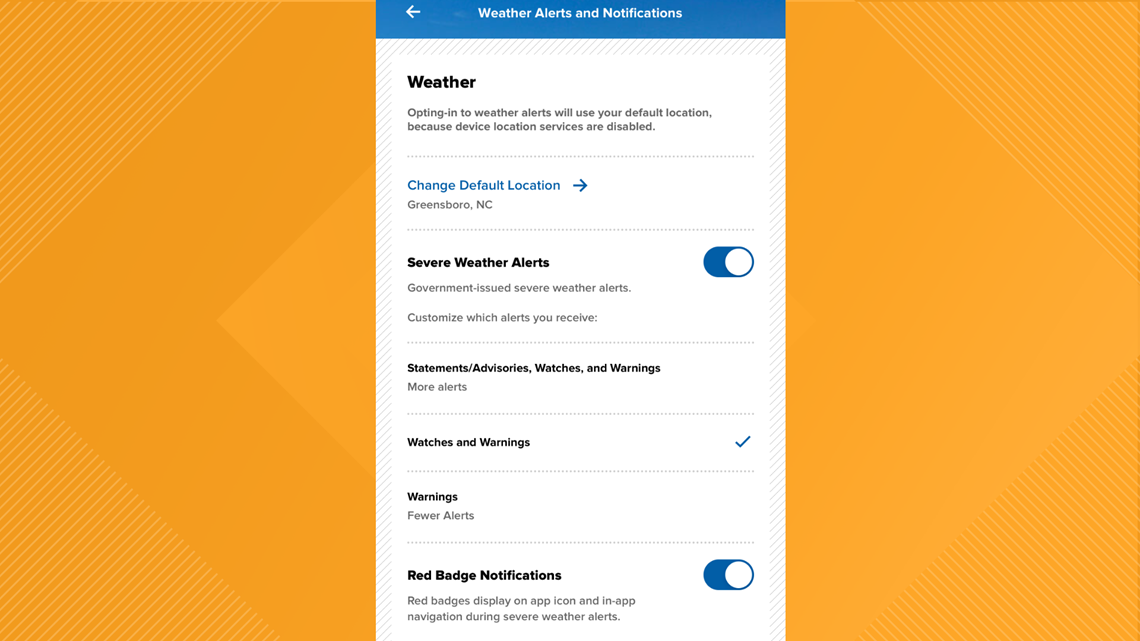
GOVERNMENT WEATHER ALERTS
On iPhone:
Click on Settings, then Notifications, next scroll to the bottom and make sure "Government Alerts" is turned on.

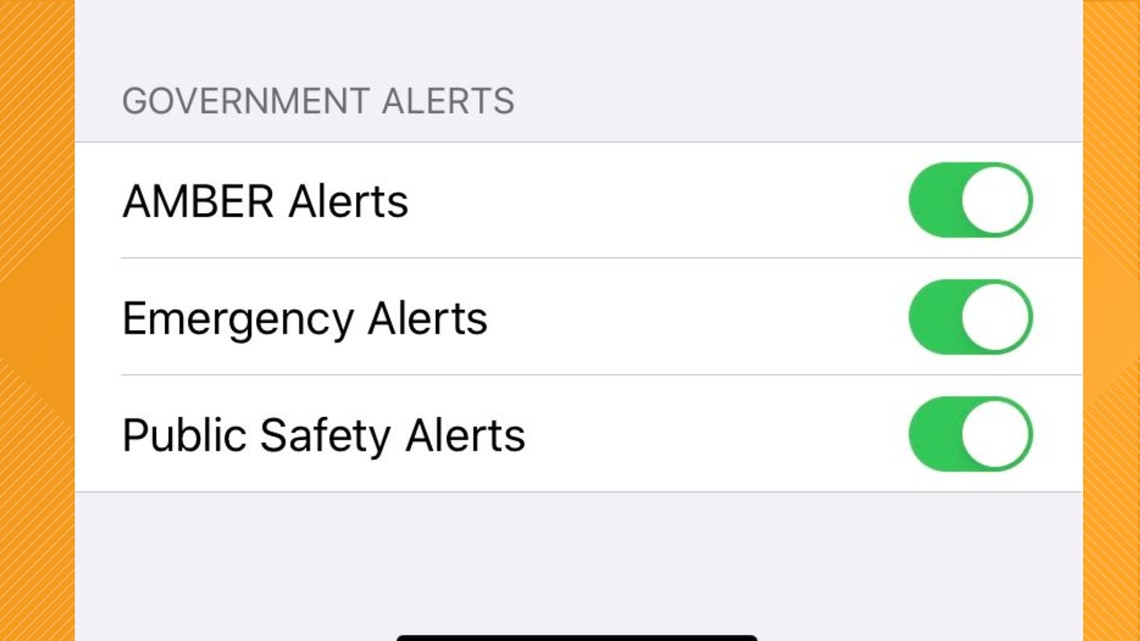
When severe weather is near – your phone will vibrate and play an emergency tone based on your location.
On Android:
You can also customize these settings usually by searching for ALERTS in the settings area on your phone. It may look a little different depending on which android-based phone you have.
But generally, search for alerts, emergency, or “cell broadcasting.” From there, you can choose which alerts you want on or off.
►For the latest weather conditions and forecast text the keyword WEATHER to 336-379-5775
OTHER EMERGENCY APPS
You’ll want to make sure you have the latest emergency apps and contacts on your phone in the event of a hurricane or other natural disaster. This will make it easier to get the information you need.
EMERGENCY CONTACTS
Program all your emergency contact numbers and email addresses into your mobile phone. It's important to include the police department, fire station and hospital, as well as family members.
NC Emergency Management: 24-Hour Operations Center -919-733-3300
- NC State Line: 211 for updates 24/7
- FEMA’s helpline: 1-800-621-FEMA
- TTY: 1-800-462-7585
- VRS: 1-800-621-3362
- Red Cross’s Helpline: 1-800-733-2727
- Red Cross Emotional Helpline: 1-800-985-5990
SAMHSA DISASTER SUPPORT LINE/EMOTIONAL SUPPORT
The Disaster Distress Helpline, 1-800-985-5990, is a 24/7, 365-day-a-year, national hotline dedicated to providing immediate crisis counseling for people who are experiencing emotional distress related to any natural or human-caused disaster. This toll-free, multilingual, and confidential crisis support service is available to all residents in the United States and its territories. Stress, anxiety, and other depression-like symptoms are common reactions after a disaster. Call 1-800-985-5990 or text TalkWithUs to 66746 to connect with a trained crisis counselor.
CONTACTING FAMILY AFTER A HURRICANE
EMERGENCY INFO.
If you need to reach your family, use your family communications plan or contact the American Red Cross at 1-800-RED-CROSS/1-800-733-2767 or visit the ARC Safe and Well site: www.safeandwell.org
If you cannot return home and need shelter, text SHELTER + your ZIP code to 43362 (4FEMA) to find the nearest shelter in your area (example: shelter 12345).
CRISIS RESPONSE: You can also learn how to use Crisis Response on Facebook to allow family and friends to know that you're safe.
EMERGENCY PLAN
Write or review your Family Emergency Plan: Before an emergency happens, sit down with your family or close friends and decide how you will get in contact with each other, where you will go, and what you will do in an emergency.
Keep a copy of this plan in a sealed tight waterproof container in your emergency supplies kit or another safe place where you can access it in the event of a disaster.
Here are four key questions to get you started on making an emergency plan:
1. How will I receive emergency alerts and warnings?
2. What is my shelter plan?
3. What is my evacuation route?
4. What is my family/household communication plan?
You can also start a plan by visiting Ready.Gov
EMERGENCY DOCUMENTS
You'll want to make sure you have important emergency documents and other items like the following also kept in a waterproof container:
- Photo ID (e.g., driver’s license, passport)
- Cash and credit cards Personal records (e.g., birth certificates, marriage certificates)
- Medical records Financial information (e.g., bank account or credit card information)
- Property records (e.g., insurance policies, deed, or lease)
EMERGENCY KIT
In the wake of a disaster, grocery stores and gas stations are often the first to run out of supplies. So it’s best to make an emergency kit.

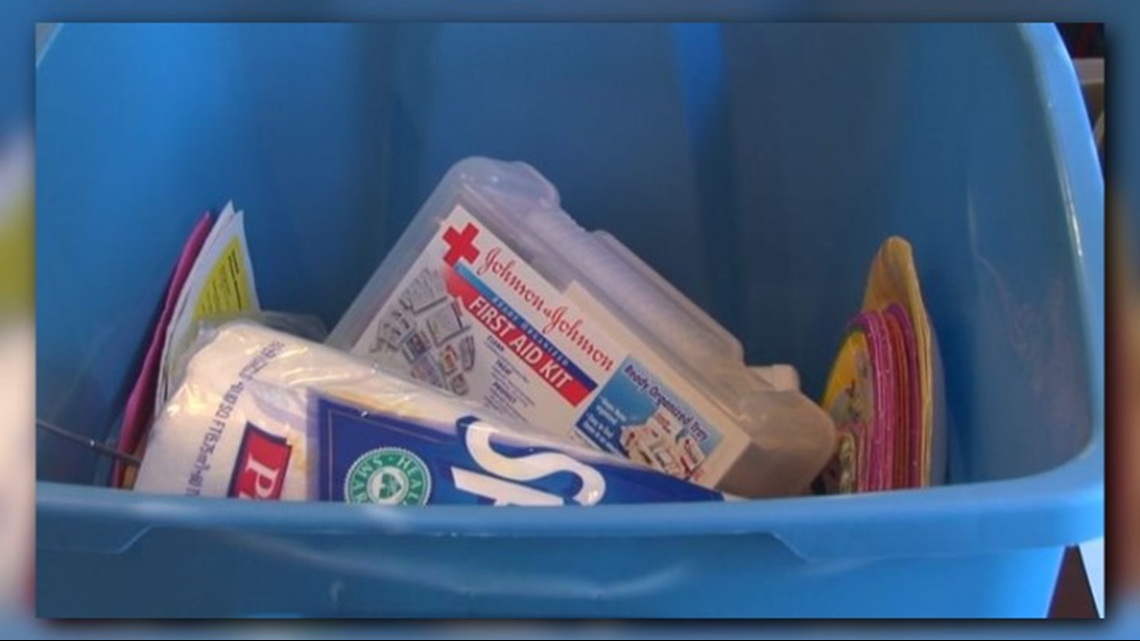
EMERGENCY KIT SUPPLIES
- Water (one gallon of water per person per day for at least three days, for drinking and sanitation)
- Food (non-perishable items, at least a 3-day supply)
- Can Opener (for any canned foods)
- Flashlights
- First Aid Kit
- Extra Batteries (for flashlight, radio, cell phone)
- Diapers & Wipes (if you have a baby or a young child)
- Toiletries & Medicine
- Pet Food & Supplies
- Whistle (to signal for help, if needed)
- Local Maps
- Plastic Bags (for sanitation and to keep electronics and important documents dry)
- Cash (if there's no power and you can't access an ATM)
- Moist towelettes, garbage bags and plastic ties for personal sanitation
- Wrench or pliers to turn off utilities
- Blankets and sleeping bags (1 per person)
- Extra house and car keys
- Fire extinguisher
- Rubber gloves
- Life jackets
EVACUATION ORDERS
In the event of a hurricane, evacuation orders could be set into place.
Follow these guidelines when evacuating:
- Listen to local media.
- Fill your car with gasoline. Take only one vehicle to lower the amount of traffic.
- Leave early enough to avoid being trapped by severe weather.
- Plan where your family will meet and go. Tell family or friends of your plans.
- Map out your path, using travel paths listed by police.
- If possible, leave and go to a friend’s home in a safe area. Next, try a motel or hotel. As a last resort, go to a shelter. Remember, shelters are not made for comfort.
- Take your family’s and pet’s emergency kits. Bring key family papers.
- Bring extra cash. Banks may be closed, and cash tellers may not work.
- Lock doors and windows before leaving your house. Unplug radios, toasters, televisions and small appliances. Be sure to turn off water, gas and power.
- Ask neighbors if they need a ride.

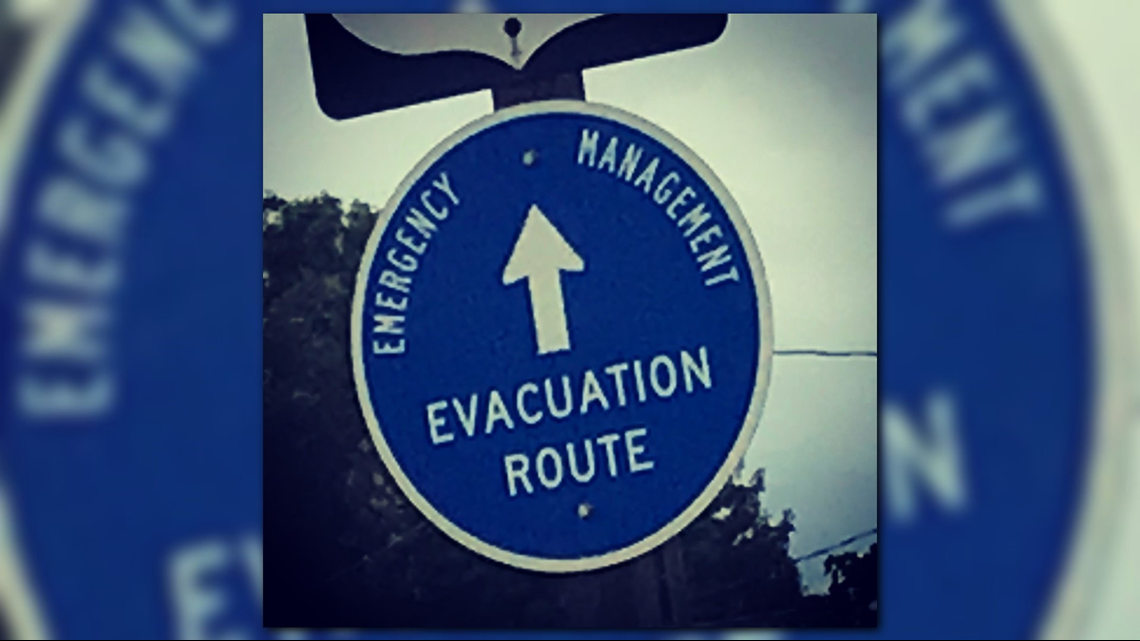
EVACUATION SUPPLIES
In the event of an evacuation make sure you have what you need to leave your home. Here's a list of supplies that you should take with you.
EVACUATION ROUTES IN NORTH CAROLINA
You'll want to make sure you have this and know your own local evacuation route.
BEFORE A HURRICANE
- Build an emergency kit.
- Make a family communications plan.
- Know you’re the routes you need to leave your home (evacuation routes). Locate your local emergency shelters.
- Closely watch/listen to the weather reports. Listening every hour as the storm nears.
- Put fuel in all vehicles and withdraw some cash from the bank. Gas stations and ATMs may be closed after a hurricane.
- If authorities ask you to leave, do so quickly.
- If you leave (evacuate), be alert to flooded or washed-out roads. Just a few inches of water can float a car. Think: Turn Around, Don't Drown.
- Keep a photo I.D. that shows your home address. You will need it when asking police if it is okay for you to re-enter your area or home.
- Secure your property.
- Bring inside all outdoor furniture, decorations, garbage cans and anything else that is not tied down.
- Cover windows with permanent storm shutters or board up windows with 5/8” plywood, cut and ready to install. Tape does not stop windows from breaking.
- Put in straps or extra clips to securely fasten your roof to the frame structure. This will lower roof damage.
- Trim trees and shrubs around your home, so they are more wind resistant.
- Clear clogged rain gutters and downspouts.
- Reinforce garage doors. If wind enters a garage it can cause dangerous and expensive structural damage.
36 HOURS AWAY FROM A HURRICANE
- Turn on your TV or radio in order to get the latest weather updates and emergency instructions.
- Restock your emergency preparedness kit. Include food and water sufficient for at least three days, medications, a flashlight, batteries, cash, and first aid supplies.
- Plan how to communicate with family members if you lose power. For example, you can call, text, email or use social media. Remember that during disasters, sending text messages is usually reliable and faster than making phone calls because phone lines are often overloaded.
- Review your evacuation zone, evacuation route and shelter locations. Plan with your family. You may have to leave quickly so plan ahead.
- Keep your car in good working condition, and keep the gas tank full; stock your vehicle with emergency supplies and a change of clothes.
18-36 HOURS AWAY FROM A HURRICANE
- Bookmark your city or county website for quick access to storm updates and emergency instructions.
- Bring loose, lightweight objects inside that could become projectiles in high winds (e.g., patio furniture, garbage cans); anchor objects that would be unsafe to bring inside (e.g., propane tanks); and trim or remove trees close enough to fall on the building.
- Cover all of your home’s windows. Permanent storm shutters offer the best protection for windows. A second option is to board up windows with 5/8” exterior grade or marine plywood, cut to fit and ready to install.
6-18 HOURS AWAY FROM A HURRICANE
- Turn on your TV/radio, or check your city/county website every 30 minutes in order to get the latest weather updates and emergency instructions.
- Charge your cell phone now so you will have a full battery in case you lose power.
6 HOURS AWAY FROM A HURRICANE
- If you’re not in an area that is recommended for evacuation, plan to stay at home or where you are and let friends and family know where you are.
- Close storm shutters, and stay away from windows. Flying glass from broken windows could injure you.
- Turn your refrigerator or freezer to the coldest setting and open only when necessary. If you lose power, food will last longer. Keep a thermometer in the refrigerator to be able to check the food temperature when the power is restored.
- Turn on your TV/radio, or check your city/county website every 30 minutes in order to get the latest weather updates and emergency instructions.
DURING A HURRICANE
- Listen to the radio or television for information.
- Secure your home, close storm shutters and secure outdoor objects or bring them indoors.
- Turn off gas, water and power if you are told to do so. Otherwise, turn the refrigerator thermostat to its coldest setting and keep its doors closed.
- Turn off propane tanks.
- Try not to use the phone, except for serious emergencies.
- Moor your boat if time permits.
- Make sure you have a supply of water for sanitary purposes such as cleaning and flushing toilets. Fill the bathtub and other larger containers with water.
- Find out how to keep food safe during and after an emergency.
- Leave your home or area if you are: Told to do so by local police.
- In a mobile home or temporary structure. Such structures are particularly dangerous during high wind events no matter how well fastened to the ground. In a high-rise building because hurricane winds are stronger at higher levels. On the coast, in a floodplain, near a river or on an island waterway.
- If you are unable to leave, go to the safest room in your house.
- Stay indoors during the hurricane. Stay away from windows and glass doors.
- Close all interior doors – secure and brace external doors.
- Keep curtains and blinds closed.
- Do not be fooled if there is a lull; it could be the eye of the storm – winds will pick up again.
- Take shelter in a small interior room, closet or hallway on the lowest level.
- Lie on the floor under a table or another sturdy object.
FLOOD WARNING AND SAFETY
With a hurricane, there’s always a potential for flooding. Here’s what you should know about flood safety.
- Know types of flood risk in your area. Visit FEMA’s Flood Map Service Center for information.
- Check out: NC Flood Maps
- If flash flooding is a risk in your location, then monitor potential signs, such as heavy rain.
- Remember to TURN AROUND, DON’T DROWN!
- If told to evacuate, do so immediately. Never drive around barricades. Local responders use them to safely direct traffic out of flooded areas.
- If your vehicle is trapped in rapidly moving water, then stay inside. If water is rising inside the vehicle, then seek refuge on the roof.
- If trapped in a building, then go to its highest level. Do not climb into a closed attic. You may become trapped by rising floodwater. Go on the roof only if necessary. Once there, signal for help.
- Stay away from high water, storm drains, ditches, ravines, or culverts
- 12 inches of water can carry away a small car
- More than half of ALL flood-related drownings occur when a vehicle is driven into floodwaters
- Many flash flood deaths occur at night
- 6 inches of fast-moving water can knock you off your feet
- It takes only 2 feet of water to float away most vehicles
- Never walk through floodwaters
- If you’re trapped by moving water move to the highest point and call 911
- If line markings on the road are not visible, DO NOT drive through the water
- Avoid driving through pools of standing water.
- Purchase or renew a flood insurance policy. It typically takes up to 30 days for a policy to go into effect and can protect the life you've built. Homeowner’s policies do not cover flooding. Get flood coverage under the National Flood Insurance Program (NFIP).
POWER LINE SAFETY
Safety Stay away from power lines that have fallen or are sagging during a storm. Consider all lines energized as well as trees or limbs in contact with lines. Report downed power lines to your local power company and to your police department.
If a power line falls across a car that you're in, stay in the car. If you MUST get out of the car due to a fire or other immediate life-threatening situation, do your best to jump clear of the car and land on both feet. Be sure that no part of your body is touching the car when your feet touch the ground.
REPORTING POWER OUTAGES
- Duke Energy: 1-800-POWERON, 1-800-769-3766 Customers may also report an outage or view current outages online
- Duke Energy Progress: 1-800-419-6356
- NC Electrical Cooperatives: 1-888-411-7870
- Energy United: 1-800-386-4833
- Randolph Electric: 1-877-736-2633
- Piedmont Electric: 1-800-449-2667
- Surry-Yadkin Electric: 336-356-8241
- City of Lexington Electric: 336-248-2337
- City of High Point Electric: 336-883-3111
GENERATOR SAFETY
You need to be especially careful during power outages, as the risk of carbon monoxide (CO) poisoning and fire increases. Here’s how you can keep your family safe.
- Use portable gas generators safely. Read the label on your generator and the owner’s manual before a storm hits.
- If you lose power, use your generator OUTSIDE your house ONLY, at least 20 feet from your home.
- NEVER use a generator inside a home, garage or shed. Carbon monoxide from generators is poisonous and can KILL you in minutes. CO is called the “invisible killer” because you cannot see it or smell it.
- Make sure you have working CO alarms in your home. They should be placed outside separate sleeping areas and on each floor of your home.
- Make sure you have working smoke alarms too. Check the batteries! They should be placed on every level of your home, outside sleeping areas and inside each bedroom.
REFRIGERATOR/COOLER TIPS
- Purchase or locate thermometers
- Place a thermometer in your refrigerator and freezer
- Have a tip-sensitive digital thermometer ready to check food temperatures
- Check stock of refrigerator
- Purchase or prepare food items that don't require refrigeration and can be eaten cold or heated on an outdoor grill
- Prepare coolers and purchase ice and/or dry ice
- Use dry ice to extend the amount of time food will stay below 41 degrees
- Purchase or freeze containers of water for ice
FOOD STOCK IN PREPARATION
- Canned food items
- Bread
- Crackers
- Granola bars
- Breakfast bars and pastries
- Cold cereal
- Nut butters
- Nuts and Seeds
- Jerky and dried meat sticks
- Powdered milk
- Canned evaporated milk
- Shelf-stable boxes of milk
- Snack puddings
- Hard cheeses
- Snack packs of cheese and crackers
- Shelf-stable canned, pouched or boxed foods
- Soups, stews and chilis
- Pasta
- Fruits and vegetables
- Fruit and vegetable juices
- Tuna
- Salmon
- Chicken
- Pork and beans
- Carrots
- Peppers
- Cucumbers
- Apples
- Bananas
- Oranges
- Other firm, fresh fruit
AFTER A HURRICANE
- Stay tuned to local radio, television, or NOAA Weather Radio for the latest news.
- Stay alert for extra rainfall and following flooding even after the storm has ended.
- Drive only if needed. Stay away from flooded roads and washed-out bridges. Stay off the streets. If you must go out, look for fallen objects, downed electrical wires, and weakened bridges, roads, and sidewalks.
- Keep away from loose or dangling power lines. Report them as quickly as you can to the power company.
- If you need to reach your family, use your family communications plan or contact the American Red Cross at 1-800-RED-CROSS/1-800-733-2767 or visit the ARC Safe and Well site: www.safeandwell.org.
- If you cannot return home and need shelter, text SHELTER + your ZIP code to 43362 (4FEMA) to find the nearest shelter in your area (example: shelter 12345).
- Return home only when officials say it is safe.
- Walk carefully around the outside your home and check for loose power lines, gas leaks, and structural damage before entering. Stay out of any building if you smell gas, if floodwaters remain around the building or your home was damaged by fire.
- Check your home for damage. Take pictures of damage, both of the building and its contents, for insurance purposes. If you have any doubts about safety, have your home check out by a trained building inspector or structural engineer before entering.
- Use battery-powered flashlights in the dark. Do NOT use candles. Note: The flashlight should be turned on outside before entering because the battery may make a spark that could cause leaking gas to catch on fire, if present.
- Many longer-term housing choices may be open to help those whose homes have been badly damaged or destroyed. Check this website or listen to local media after a hurricane to learn what choices may be open to you.
- Watch your pets closely and keep them under your direct control. Watch out for wild animals, especially poisonous snakes. Use a stick to poke through debris.
- Do not drink or make food with tap water until you are sure it’s not dirty.
- Check refrigerated food for spoilage. If in doubt, throw it out.
- Wear protective clothing and be cautious when cleaning up to not get hurt.
- Use the telephone only for emergency calls.
- NEVER use a generator inside homes, garages, crawlspaces, sheds, or other enclosed areas, even when using fans or opening doors and windows for airing. Deadly levels of carbon monoxide can quickly build up in these areas and can stay around for hours, even after the generator has shut off.
- Find out more about making a claim: NC Hurricane Claims Information
Stay connected to local, national and breaking news: Download the new WFMY News 2 app.
►Text the keyword APP to 336-379-5775
►For the latest weather conditions and forecast text the keyword WEATHER to 336-379-5775
►For local news stories right to your phone text the keyword NEWS to 336-379-5775
►Need our Call for Action Team? Text keyword CFA to 336-379-5775
►For traffic alerts text the word TRAFFIC to 336-379-5775

